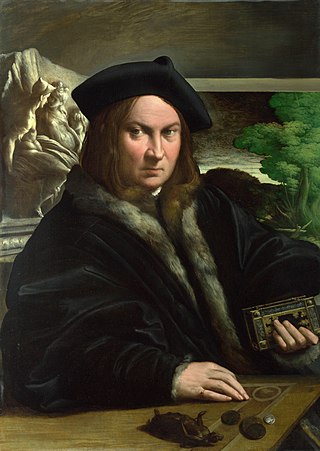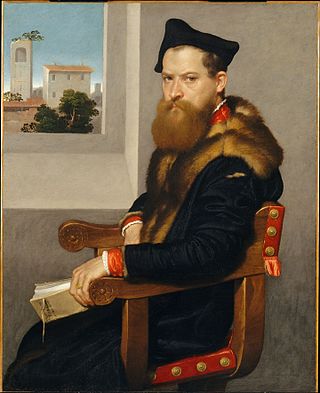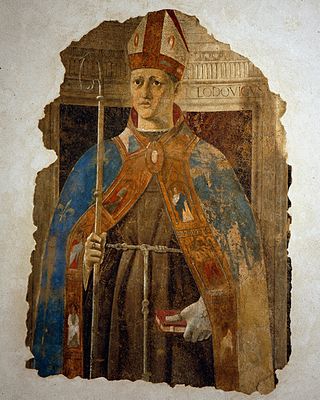The Salimbeni Prize is awarded by the Fondazione Salimbeni per le Arti Figurative of San Severino Marche to honour excellence in the writing of art history on an Italian subject. The Premio Salimbeni was established in 1983.

Girolamo Francesco Maria Mazzola, also known as Francesco Mazzola or, more commonly, as Parmigianino, was an Italian Mannerist painter and printmaker active in Florence, Rome, Bologna, and his native city of Parma. His work is characterized by a "refined sensuality" and often elongation of forms and includes Vision of Saint Jerome (1527) and the iconic if somewhat anomalous Madonna with the Long Neck (1534), and he remains the best known artist of the first generation whose whole careers fall into the Mannerist period.

Antonio Mancini was an Italian painter.

Antea is a painting by the Italian Mannerist artist Parmigianino. The painting is in the collection of the Museum of Capodimonte in Naples, Italy.

Remo Bianco, birth name Remo Bianchi, was an Italian painter and sculptor.

Portrait of a Collector is an oil on canvas painting by the Italian Mannerist artist Parmigianino, created c. 1524. It is held at the National Gallery, in London.

Turkish Slave, also called Portrait of a Young Woman, is a painting by the Italian Mannerist artist Parmigianino. The painting was executed around 1533. It is housed in the Galleria nazionale di Parma.

Portrait of Pier Maria Rossi di San Secondo is a painting by the Italian Mannerist artist Parmigianino, executed around 1535–1539 and housed in the Museo del Prado, Madrid, Spain. The subject was Count of San Secondo, and the painting forms a pair with a group portrait of his Countess and their children, Portrait of Camilla Gonzaga and Her Three Sons, although the latter is not unanimously attributed to Parmigianino.

Portrait of Camilla Gonzaga and Her Three Sons is a painting attributed to the Italian Mannerist artist Parmigianino and his workshop, executed around 1535–1537 and housed in the Museo del Prado, Madrid, Spain. It forms a pair with another painting in the Prado, the Portrait of Pier Maria Rossi di San Secondo, Camilla's husband, a painting which is unanimously assigned to Parmigianino.

The Vision of Saint Jerome of The Madonna and Child with Saints is a painting by the Italian Mannerist artist Parmigianino, executed in 1526–1527. It is in the collection of the National Gallery, in London.

Paolo Bolpagni is an Italian art historian, critic and curator.

The Bolognini Madonna is an oil-on-panel painting executed ca. 1514–1519 by the Italian Renaissance painter Antonio da Correggio.

Pablo Echaurren is an Italian painter, comics artist and writer.

The Portrait of Bartolomeo Bonghi is an oil on canvas portrait by Italian artist Giovanni Battista Moroni, created in 1553. It is held at the Metropolitan Museum of Art, in New York. It depicts Bartolomeo Bonghi, a 16th-century Italian legal scholar. The portrait presents its subject as he was in life; a man of wealth and status. The buildings seen in the top left-hand corner of the painting identify the site of the portrait's sitting as Bergamo in Lombardy.

Mystic Marriage of Saint Catherine or Mystic Betrothal of Saint Catherine is a 1567-1570 oil on panel painting by Giovanni Battista Moroni, produced for the side-altar of Catherine of Alexandria in the church of San Bartolomeo, parish church of Almenno San Bartolomeo, where it still hangs. It is signed at lower right IO:BAP.MORONUS.P. The church had been begun in 1520 through the will of Giorgio Rota, but work lapsed until restarting in 1562. The painting draws on the composition of Moretti's 1539 Rovelli Altarpiece.

Portrait of a Man in a Red Beret or Self-Portrait in a Red Beret is an oil on paper painting attributed to Parmigianino or Michelangelo Anselmi, executed c. 1540, now in the collection of the National Gallery of Parma.

Saint Louis of Toulouse is a fresco fragment of 1460 by Piero della Francesca, removed from its original wall in the former Palazzo Pretorio in Sansepolcro, Tuscany, in the mid-19th century, and now in the Museo Civico in the same town. The detachment destroyed a Latin inscription recording Ludovico Acciaioli as the commissioner and 1460 as the work's date, on the occasion of the town's revival of the role of gonfaloniere of justice.

Giovanni Maria Mosca or Giovanni Padovano was an Italian Renaissance sculptor and medallist, active between 1515 and 1573, initially in the Veneto and after 1529 in Poland, where his first name was rendered Jan.

The Portrait of a Woman with Mask is a pastel painting by the Venetian artist Rosalba Carriera, completed between 1720 and 1730. It is in the collection of the Palazzo Melzi d'Eril, in Milan. Its dimensions are 56 by 47 cm.

The Portrait of a Man Holding a Letter, also known as The Lawyer, is an oil on canvas painting by Italian painter Giovanni Battista Moroni, from 1570-1572. It is held at the National Gallery, in London. It is considered one of the most representative paintings of the artist's maturity.




















